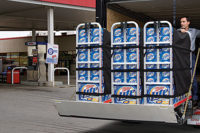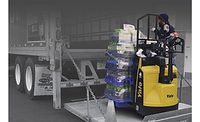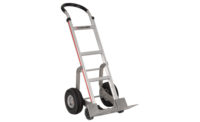According to the Occupational Safety and Health Administration (OSHA), musculoskeletal disorders (MSDs), or ergonomic injuries, are one of the most common injuries route delivery drivers encounter and accounted for 33 percent of all workplace injuries and illnesses requiring days away from work for all occupations in 2011. Of these injuries, heavy and tractor-trailer truck drivers, such as beverage delivery drivers, had the greatest median days away from work for the MSD injury category, OSHA stated in its November 2012 report, “Nonfatal Occupational Injuries and Illnesses Requiring Days Away From Work, 2011.” More than one-third of MSDs for heavy and tractor-trailer truck drivers were back injuries, and more than 16 percent were shoulder injuries, it reports.
To prevent such injuries, create a safer working environment and save companies money from workers’ compensation claims, the carts and hand trucks industry has worked to develop more ergonomic methods of beverage delivery.
For example, Standish, Mich.-based Magline Inc. developed both its Bulk Delivery Truck and CooLift Delivery System for ergonomic delivery. Both delivery vehicles are designed to be loaded with product in an environmentally controlled warehouse rather than at the delivery site, and then these vehicles are loaded onto and unloaded from a truck by use of a liftgate or specialized jack. “One of the key ideas to this is that they reduce the amount of bending and twisting that the driver has to do,” explains Joe Howeth, sales system manager for Magline. With this method, the delivery driver does not have to bend to move the product and instead only maneuvers the cart or delivery system, he says.
For the Bulk Delivery Truck, deliveries are loaded onto the cart in the warehouse, and then the whole cart is loaded onto and unloaded from the truck using the truck’s liftgate. Then the cart is wheeled into the store or delivery site by the delivery driver, Magline’s Howeth says. The CooLift Delivery System uses 43-inch-, 48-inch- or 53-inch-long “half pallets” that also are preloaded in the warehouse but are loaded onto and unloaded from the delivery system by means of a six-wheeled pallet jack that picks up the half pallets and converts into a cart for pallet delivery, he says.
To further minimize back-bending and overexertion in beverage delivery, Sheffield Village, Ohio-based Benko Products offers the Erg-O-Cart for ergonomic keg delivery. Instead of bending to load and unload a keg, the Erg-O-Cart allows the user to load and unload the keg at waist level while standing straight up, says Russ Monchein, a sales and marketing representative for Benko. “You would have to push down on it, and it allows that person to push it down to whatever height they want,” he says. “The gas shocks that are in there allow that weight to be moved up and down real easily.”
Similarly, Diverse Manufacturing Solutions (DMS), a brand of 1 Stop Material Handling Inc., North Easton, Mass., offers Levelizer technology for carts and hand trucks that uses Constant Force Springs to maintain proper ergonomic positions, says Kate Shepard, operations assistant for 1 Stop Material Handling. This also is a green solution because it does not require electric, hydraulic or air power, she adds.
Beyond bending and lifting, managers in the delivery industry also are concerned about delivery personnel maneuvering too much weight on their carts and hand trucks. Bill Joseph, national sales manager for Magline, says that customers are calling for certain types of handles that limit the amount of weight a hand truck can carry. “Now companies are stepping in and basically banning certain types of handles because they don’t want excessive weight on a hand truck; they want drivers to be limited because they want to cut down on catastrophic injuries,” he says.
To manage this safety concern, Magline offers an entire portfolio of different hand truck heights to limit users to manageable weights, he notes.
Falls are another common cause of injury in beverage delivery, notes Carl Boettcher, national accounts manager for HTS Systems Lock N Roll LLC, Scranton, Pa. “Drivers have fallen off and out of their box truck onto their hand truck,” he says. “These types of fall injuries can be extremely dangerous, painful and costly. Fall injury accidents from 4 to 5 feet can cost companies over $25,000 in surgery, doctor visits, insurance costs and wages.”
To reduce the number of times a driver needs to climb into and out of a truck to load or unload a hand truck before or after use, HTS offers its HTS Ultra Rack/Hand Truck Sentry System, which allows the user to mount the hand truck on the outside of the delivery vehicle for easier storage and retrieval, he says. This also saves space inside of the delivery vehicle and prevents the driver from forgetting the hand truck by alerting him or her when the hand truck is absent or not properly mounted, he adds.
Versatile variations
Sometimes delivery requirements dictate a need for different cart and hand truck capabilities to get the job done. For moving heavy loads like vending machines up and down stairs, delivery operators can turn to a product like Ultra Lift powered hand trucks (PHTs), says George Dabb, president of San Jose, Calif.-based Ultra Lift Corp. Once the vending machine is strapped onto the Ultra Lift, the operator uses leverage and balance to break back and maneuver the load while the PHT does the lifting, he explains. Working one stair at a time, the Ultra Lift allows the operator to deliver the vending machine by raising the wheels first and then bringing the load up each step by means of the powered lift, according to the company’s website. In addition, the company offers a Portable Landing Extender, which adds 33 inches to small landings, and a StrongArm Extension Handle, which adds an extra 12 inches of leverage to the Ultra Lift, reducing operator effort on stairs by 50 percent, Dabb says.
Similarly, one of 1 Stop Material Handling’s brands has developed an affordable device to transport kegs safely into basements, Shepard explains. The device currently is in testing and will be unveiled upon successful testing completion, she says.
As an affordable option for operating in varying environments, Magline offers its Gemini series of hand trucks that can function as both two-wheeled hand trucks and four-wheeled carts, Joseph says. A user can push or pull the cart in a four-wheeled position and then fold down the handle and two additional wheels to convert it into a two-wheeled hand truck, he explains.
For some customers, the bottom line comes down to whether or not the cart or hand truck can get the job done efficiently. Many of Gleason Corp.’s customers look for high load capacity, says John Pinderski, national sales manager for the Los Angeles-based company. To meet this need, the company’s Milwaukee Hand Trucks brand offers its model No. 47186 High Stacking Truck, which offers greater stacking capability and can handle up to 600 pounds, Pinderski says. In addition, Milwaukee Hand Trucks can be fitted with frame extenders to make the hand trucks even taller for increased stacking ability, he adds.
Getting the job done efficiently also means increased durability and easy repairs. Magline designs its hand trucks with modular parts so that broken or worn-out parts can be replaced instead of requiring a whole new hand truck, Joseph says. This change-out feature gives the hand trucks “a continuation of life,” he says. “When you start talking about a 10- [or] 12-year-old hand truck, that’s a heck of a lifespan when you’re just throwing a few parts on it.”
The culture of hand trucks
More than just bending to meet ergonomics standards, carts and hand trucks also morph to meet cultural standards and delivery requirements as well. For example, companies on the East and West Coasts prefer different types of hand trucks, says Bill Joseph, national sales manager for Magline Inc., Standish, Mich.
“The West Coast uses a double-loop handle; it has two loops that you put your hands on simultaneously,” he explains. “If you were to take that to the East Coast, literally drivers would [say], ‘I can’t use this; I can’t work with this.’ It’s so foreign to them and vice versa. If you brought an East Coast truck to the West Coast, it would be received with the same disdain. They’re very particular, and it’s a cultural thing, believe it or not.”
Customers on the East Coast prefer to use aluminum hand trucks because of the material’s flexibility, Joseph says. “If you would consider an airplane, would you want rigid wings or would you want wings that flex with motion and with movement?” he asks hypothetically, referring to an analogy he learned from Magline engineers. “That would apply to a hand truck as well: If the driver is pulling on a steel hand truck, it has zero flexibility and zero give, so all of the impact of the job echoes throughout [the user’s] body, versus the flexibility that an aluminum hand truck provides: It takes the emphasis of the stress and puts it on the hand truck and deemphasizes the stress on the body.”
Across the country, West Coast users prefer steel hand trucks because they perceive steel to be more durable, he says. Although Magline’s hand trucks are mostly made of aluminum, the company developed a steel nose option for its hand trucks to appease consumers in this market, he adds.








